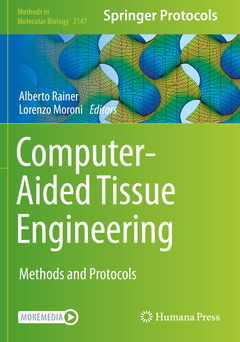Description
Computer-Aided Tissue Engineering, 1st ed. 2021
Methods and Protocols
Methods in Molecular Biology Series, Vol. 2147
Coordinators: Rainer Alberto, Moroni Lorenzo
Language: English
Subject for Computer-Aided Tissue Engineering:
Publication date: 08-2021
188 p. · 17.8x25.4 cm · Paperback
Publication date: 08-2020
Support: Print on demand
Description
/li>Contents
/li>Comment
/li>
This volume details protocols encompassing different aspects of computer aided design and manufacturing of 3D scaffolds and biofabricated constructs for tissue engineering applications. Chapters are divided into four parts covering optimization of scaffold architectures for computer aided tissue engineering, synthetic routes to biomaterials compatible, technological platforms and manufacturing processes, and relevant applicative scenarios. Written in the highly successful Methods in Molecular Biology series format, chapters include introductions to their respective topics, lists of the necessary materials and reagents, step-by-step, readily reproducible laboratory protocols, and tips on troubleshooting and avoiding known pitfalls.
Authoritative and cutting-edge, Computer-Aided Tissue Engineering: Methods and Protocols aims to be useful for new and experienced laboratory researchers working on different aspects of corneal regeneration.
1. Biomimetic Boundary-based Scaffold Design for Tissue Engineering Applications
Henrique A. Almeida and Paulo J. Bártolo
2. Triply Periodic Minimal Surfaces (TPMS) for the Generation of Porous Architectures Using Stereolithography
Sebastien B.G. Blanquer
3. 3D Printing Of Functionally-graded Films by Controlling Process Parameters
A. Bonfanti, L. Domenicale, and A. Bhaskar
4. Photocurable Biopolymers for Coaxial Bioprinting
Marco Costantini, Andrea Barbetta, Wojciech Swieszkowski, Dror Seliktar, Cesare Gargioli, and Alberto Rainer
5. Synthesis of an UV-curable Divinyl-fumarate Poly-ε-Caprolactone for Stereolithography Applications
Ronca A., Ronca S., Forte G., and Ambrosio L.
6. Nanocomposite Clay-based Bioinks for Skeletal Tissue Engineering
Gianluca Cidonio, Michael Glinka, Yang-Hee Kim, Jonathan I. Dawson, and Richard O.C. Oreffo
7. Additive Manufacturing using Melt Extruded Thermoplastics for Tissue Engineering
Andrea Roberto Calore, Ravi Sinha, Jules Harings, Katrien V. Bernaerts, Carlos Mota, and Lorenzo Moroni
8. Computer-aided Wet-spinning
Dario Puppi and Federica Chiellini
9. Production of Scaffolds Using Melt Electrospinning Writing and Cell Seeding
E. C. Bolle, D. Nicdao, P.D. Dalton, and T.R. Dargaville
10. Low Voltage Continuous Electrospinning: A Versatile Protocol for Patterning Nano-and Micro-Scared Fibers for Cell Interface
Zhaoying Li, Xia Li, and Yan Yan Shery Huang
11. Direct Write Deposition of Thermogels
Sara Maria Giannitelli, Valeria Chiono, and Pamela Mozetic
12. 3D Bioprinting of Complex, Cell-laden Alginate Constructs
Atabak Ghanizadeh Tabriz, Dirk-Jan Cornelissen, and Wenmiao Shu
13. Surface Tension-assisted Additive Manufacturing of Tubular, Multicomponent Biomaterials
Elia A. Guzzi, Héloïse Ragelle, and Mark W. Tibbitt
14. Bioprinting of Complex Vascularized Tissues
Wei Zhu, Claire Yu, Bingjie Sun, and Shaochen Chen
15. A Scaffold-free 3D Bioprinted Cartilage Model for in vitro Toxicology
Pallab Datta, Yang Wu, Yin Yu, Kazim K. Moncal, and Ibrahim T. Ozbolat
Includes cutting-edge methods and protocols
Provides step-by-step detail essential for reproducible results
Contains key notes and implementation advice from the experts
These books may interest you

Computer-Aided Tissue Engineering 105.49 €



